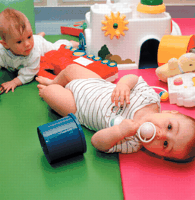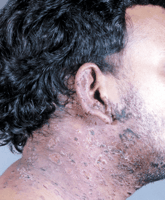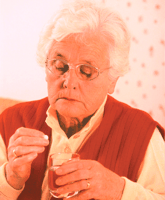This week in the BMJ
Volume 330,
Number 7503,
Issue of 4 Jun 2005
![[Down]](/icons/down.gif) Leukaemia: avoid living near high voltage lines...
Leukaemia: avoid living near high voltage lines...
![[Down]](/icons/down.gif) ... and let your baby acquire infections early in life
... and let your baby acquire infections early in life
![[Down]](/icons/down.gif) Co-prescribed heroin adds value to methadone treatment
Co-prescribed heroin adds value to methadone treatment
![[Down]](/icons/down.gif) HIV infections should be diagnosed earlier
HIV infections should be diagnosed earlier
![[Down]](/icons/down.gif) Aspirin to prevent cardiovascular disease in elderly people: the jury's still out
Aspirin to prevent cardiovascular disease in elderly people: the jury's still out
![[Down]](/icons/down.gif) Heterosexual HIV is still mostly imported to the UK
Heterosexual HIV is still mostly imported to the UK
Leukaemia: avoid living near high voltage lines...
Children who, at birth, live near high voltage power lines in England and Wales are more at risk of getting leukaemia than children who don't. In a case-control study of more than 29 000 children with cancer and their matched controls, Draper and colleagues (p 1290) found that—compared with children who lived more than 600 m away from the power lines—children who lived within 200 m and between 200 m and 600 m away had a significantly increased risk of leukaemia (relative risk 1.69 and 1.23, respectively). The authors think the relation may be due to chance or confounding.

| |
Credit: PETER PARKS/AFP/GETTY
|
|
![[To top]](/icons/back.gif)
... and let your baby acquire infections early in life
Children who are exposed to regular social activities outside their families in the first few months of their life are less likely to develop acute lymphoblastic leukaemia later on. Using day care and social activity as proxies for exposure to infection, Gilham and colleagues (p 1294) compared more than 3000 children with cancer with more than 6000 controls. They not only found an association but also a significant dose-response trend (P < 0.001). Other malignancies showed a similar pattern.

| |
Credit: BURGER/PHANIE/REX
|
|
![[To top]](/icons/back.gif)
Co-prescribed heroin adds value to methadone treatment
Adding heroin to methadone treatment of chronic heroin addicts who had been resistant to treatment is cost effective from a societal perspective. In a cost utility analysis based on two randomised controlled trials, Dijkgraaf and colleagues (p 1297) found co-prescribed heroin to be associated with 0.058 more quality adjusted life years per patient per year and a mean saving of £8793 per patient per year. The initial higher cost of adding heroin to the treatment was compensated for by lower costs of law enforcement and damage to victims of crime.

| |
Credit: ACT/REX
|
|
![[To top]](/icons/back.gif)
HIV infections should be diagnosed earlier
In the United Kingdom and Ireland, some 30% of people infected with HIV are being diagnosed late (with CD4 lymphocyte counts below 200 cells/µl) and only about 40% through routine screening. In a national case review, Sullivan and colleagues (p 1301) used structured questionnaire forms to obtain data on 977 patients from 113 centres that provide care for adults with HIV infection. One in five HIV positive patients had had symptoms that were likely to be related to HIV in the year before the diagnosis.

| |
Credit: M A ANSARY/SPL
|
|
![[To top]](/icons/back.gif)
Aspirin to prevent cardiovascular disease in elderly people: the jury's still out
We don't know how justified routine use of low dose aspirin is for primary prevention of cardiovascular disease in people aged 70 and more. Nelson and colleagues (p 1306) undertook epidemiological modelling in a hypothetical population of 20 000 men and women with the reference population of Victoria, Australia, and showed that aspirin prevented 710 myocardial infarctions and 54 ischaemic strokes. However, it also provoked the onset of gastrointestinal and intracranial bleeding in 1071 and 130 patients, respectively. Wide confidence intervals leave room for the overall effect to be either beneficial or adverse.

| |
Credit: SUSA/FOTEX/REX
|
|
![[To top]](/icons/back.gif)
Heterosexual HIV is still mostly imported to the UK
Transmission of HIV through heterosexual intercourse is rising steadily in the United Kingdom but still accounts for less than 10% of all diagnosed patients. Dougan and colleagues (p 1303) examined national surveillance data for 21 115 adults infected through heterosexual intercourse between 1985 and 2003. According to the data, about one in 10 people was infected in the UK and almost two thirds had a sexual partner who was infected outside Europe. The number of people infected in the UK alone rose from 144 in 1999 to 315 in 2003.
![[To top]](/icons/back.gif)
Leukaemia: avoid living near high voltage lines...
... and let your baby acquire infections early in life
Co-prescribed heroin adds value to methadone treatment
HIV infections should be diagnosed earlier
Aspirin to prevent cardiovascular disease in elderly people: the jury's still out
Heterosexual HIV is still mostly imported to the UK




